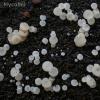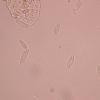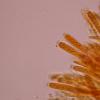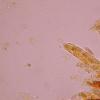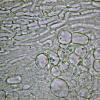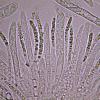
03-01-2013 21:00
 Alessio Pierotti
Alessio Pierotti
I SEARCH THIS WORK:Cannon, P.F. (1988). Proposal t

03-01-2013 14:49
 Edit Szilvásy
Edit Szilvásy
Dear FORUM, This ascomycota was found by my girlfr

01-01-2013 21:52
Esquivel-Rios EduardoHi All.This fungi is similar to C. labellum, but h

01-01-2013 18:10
Hello again and happy new year for allTogether wit

01-01-2013 21:01
Esquivel-Rios EduardoHi AllHere a photos of unknown cup fungi found in

31-12-2012 17:12
Hi again:Yesterday I have collected on Tilia wood
Bonjour à tous,
je reviens sur ce forum après une longue absence.
Je "sèche" sur ce petit asco blanc, poussant à la base d'un feuillu encore à moitié en vie, sous l'écorce qui s'enlève. Apothécies jusque 4.5 mm, blanc à crème. Après 2 jours dans ma boîte au frais on dirait que cela rougit un peu aux blessures...
Fixation au substrat par un point d'attache central, non stipité, concolore.
Disque apical des asques réagissant en gris-bleu légèrement au lugo et au Meltzer. Asques jusque 80-90 x 8-10 µm.
Paraphyses droites, septées 1 à 2x, même longueur que les asques, x 2-3 µm. Ces paraphyses présentent un contenu granulé visible surtout dans le réactif de Baral 3-6.
Spores (8 par asque) de dimensions
9,6 [11,1 ; 12,4] 13,8 x 3,7 [4,1 ; 4,4] 4,7 µm
Q = 2,2 [2,6 ; 2,9] 3,3 ; N = 11 ; C = 95%
Me = 11,7 x 4,2 µm ; Qe = 2,8
avec un très petit contenu. Pas de guttule, juste quelques petites granulations peu nombreuses.
Merci pour votre aide éventuelle, je suis à l'écoute des réactions éventuelles également encore à effectuer.
Yves Deneyer

Content de te voir de retour sur ce forum !
J'espère que tu vas bien.
Tes apothécies sont elles bien complètement sans poils ? Dans ce cas , il pourrait s'agir de Hymenoscyphus imberbis.
C'est une récolte en zone humide ?
Le rougissement des apothécies est du à l'oxydation des guttules contenues dans les paraphyses.
Tu devrais avoir aussi dans les cellules de l'excipulum ectal des guttules réfringentes (à observer surtout dans l'eau).
Amitiés
Michel
Pourquoi pas Phaeohelotium subcarneum? (si poils)
Camille
Décidément je retrouve tout le monde ici...
Il n'y a absolument aucun poil.
Ce n'est pas en zone humide, mais vu ce qu'il est tombé dernièrement, toute zone est humide ou presque.
Yves

did you test the black stromatic tissue around these apothecia?
Regards,
Martin
There is no tissue between the apothecias. It's due to the light reflect on the wood, it was so wet ...
Thanks

